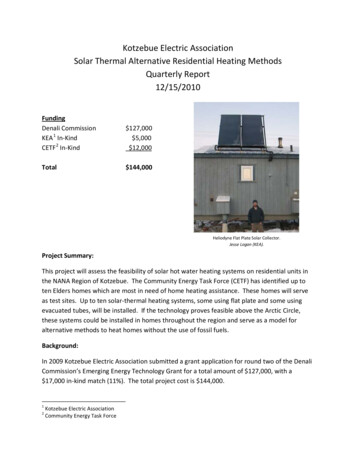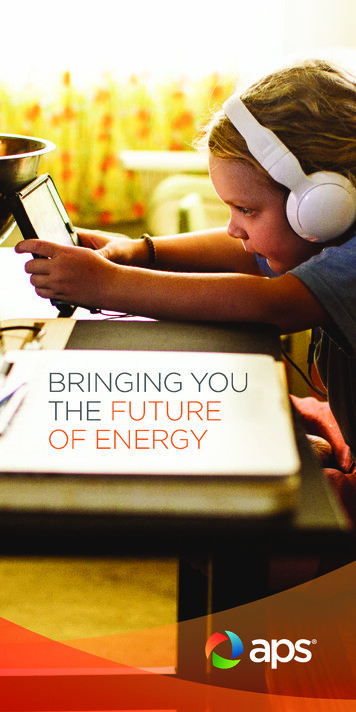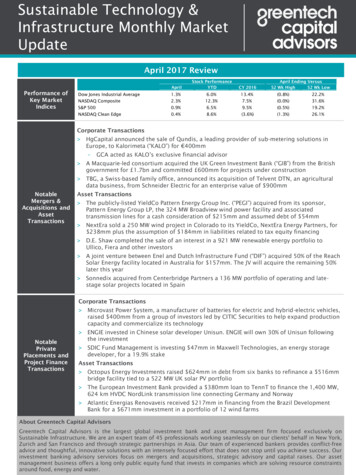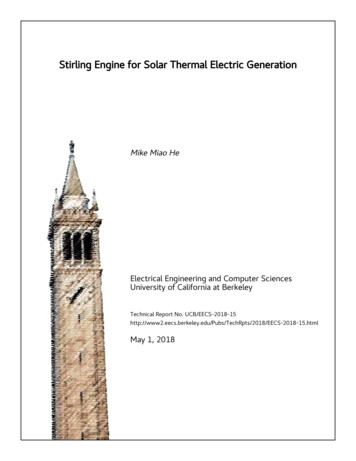
Transcription
Kotzebue Electric AssociationSolar Thermal Alternative Residential Heating MethodsQuarterly Report12/15/2010FundingDenali CommissionKEA 1 In-KindCETF 2 In-Kind 127,000 5,000 12,000Total 144,000Heliodyne Flat Plate Solar Collector.Jesse Logan (KEA).Project Summary:This project will assess the feasibility of solar hot water heating systems on residential units inthe NANA Region of Kotzebue. The Community Energy Task Force (CETF) has identified up toten Elders homes which are most in need of home heating assistance. These homes will serveas test sites. Up to ten solar-thermal heating systems, some using flat plate and some usingevacuated tubes, will be installed. If the technology proves feasible above the Arctic Circle,these systems could be installed in homes throughout the region and serve as a model foralternative methods to heat homes without the use of fossil fuels.Background:In 2009 Kotzebue Electric Association submitted a grant application for round two of the DenaliCommission’s Emerging Energy Technology Grant for a total amount of 127,000, with a 17,000 in-kind match (11%). The total project cost is 144,000.12Kotzebue Electric AssociationCommunity Energy Task Force
Solar thermal systems are not new technology. Using solar thermal power to activelysupplement other methods of water and space heating has many benefits; however thedeployment in northern Alaska has been nearly non-existent for several reasons, but primarilyeconomic. As fossil fuel prices continue to rise the benefits of solar thermal will becomeincreasingly obvious. Initial modeling done in ReScreen showed a payback on these systems inless than 8 years-finance depending- but must first be demonstrated in order to streamline thedesign of these systems using off-the-shelf technology. However, in the time between theinitial grant application and the following award the price structures of the equipment andlabor increased.The objective of this project is to mitigate the rising costs of home heating in rural Alaska. KEAwill install up to ten solar-thermal heating systems, each in different homes, to assess thefeasibility of this technology above the Arctic Circle. To our knowledge not many people haveexperimented with this technology at this latitude, however Alaska Battery Systems hasinstalled one system in Nome, and the Cold Climate Housing Research Center has installed bothan evacuated tube space heating solar thermal system and a glazed panel water heating systemin Fairbanks. Each has their advantages and disadvantages. The purpose of this project is todetermine the most efficient combination for home space and/or water heating.Modeling done in RetScreen has shown that the Northwest Arctic Region can obtain a 50%solar refraction on a properly designed system. Meaning solar energy could reduce theircurrent energy use by half. However, conservatively, KEA is expecting to see a 30% reduction infuel use for domestic hot water heating and a less substantial reduction in home space heating.The original grant proposal suggested at least four air-source heat pumps to be installed todetermine if the technology would reduce energy costs to homeowners in the Arcitic.However, due to their technical challenge and to poor track record as related from an NRECAreport it was determined that the defrost cycles experienced in states such as Ohio would havecost a large energy cost increase to the home owner. Therefore, KEA has decided to focus onflat plate and evacuated tube solar collectors for water and space heating. Tracking mountingfor solar collectors was also discussed but again risked the increase of electrical consumptionfor the home owner. In keeping with the attempt of reducing home owner’s cost of energy andease of operation (as home owners are Elders) track mounting options were dismissed.Hybrid air source heat pump hot water heaters (GE 50-Gallon GeoSpring Hybrid WaterHeater) have also been discussed with one eligible home identified as suitable for thisinstallation. Up to 20% of the total heating fuel in the Northwest Arctic Borough is used to heathot water. While solar thermal hot water is practical up to nine months of the year, thesehybrid hot water heaters utilize both air-source and electrical energy. By combining the two,KEA had hoped to provide reliable hot water to this home while attaining the manufacturers
estimated 62% reduction in electrical consumption for hot water. However, budget constraintsmay not allow this installation.There are numerous ways to design solar thermal space and hot water heating systems withflat plates or evacuated tubes. Each installation will have a slightly different configuration toallow KEA to make a comparison for each home and recommend system designs accordingly.Project Work PlanA. Site Identification, Planning, and EquipmentSite Identification: CompleteKEA has coordinated with the Kotzebue CETF to identify homes that are suitable for thisdemonstration project. KEA and CETF had over 25 applicants and 10 met the following criteria:Elders status in Kotzebue, full-time Elders residence, and currently on State Energy Assistance.KEA then worked with CETF and Susitna Energy Systems (SES) designers to identify the homeswith the least amount of equipment needed in order to demonstrate the most systems. Aftercareful review, and pricing evaluations, 6 homes where selected for solar collectors and oneadditional home was identified as suitable for a hybrid air-source electric hot water heater, ifthe budget allows.Planning: CompleteSeveral of the 6 homes selected for this demonstration project utilize hydronic base boardheating to heat the homes. In this type of home heating system a glycol based fluid is heatedby the same boiler that domestic hot water is heated. It is therefore possible to allow a solarthermal collector to pre-heat both systems. This requires slightly more complex plumbing aswell as more advanced thus more expensive, storage tanks.In order to best demonstrate the capacity of solar thermal collectors to reduce fossil fuelconsumption, and therefore energy cost, KEA deemed it necessary to install both DHW(domestic hot water) systems as well as combined DHW and hydronic base board heatingcapacity. Again, the selection of which homes would receive DHW or combined systems wasbased on costs of installation and space within the home’s utility room to accommodate thenecessary equipment.This demonstration project also needed to evaluate the production differences between flatplate and evacuated tube solar collectors. There are several manufacturers with respectablereputations that make both types of collectors, but only two that are well represented with
installation companies here in Alaska: Viessmann Manufacturing Company Inc. represented byGensco Alaska and installed by Susitna Energy Systems (SES), and Heliodyne Inc. representedand installed by Alaska Battery Systems (ABS). KEA elected to split the 6 homes between thetwo manufacturing and installation companies as well as purchases both flat plates andevacuated tubes from each.Viessmann Inc was reluctant to install their equipment to serve as combined DHW and heatingas it was designed for DHW only. Therefore KEA chose to purchase 2 flat plate and 1 evacuatedtube collector from Viessmann to be installed by SES. Heliodyne was more flexible in theirsystem design capacity and with ABS having experience installing a combined DHW and heatingsolar thermal system in Nome, KEA felt comfortable purchasing 2 flat plat and 1 evacuated tubecollector from Heliodyne to be installed by ABS.Generally, evacuated tube solar thermal collectors have performed slightly better than flatplate collectors in the lower 48. However, evacuated tubes are more expensive and have thecapacity to be more troublesome and fragile. Therefore, in the interest of installing and testingthe most systems, KEA elected to install 2 evacuated tube and 4 flat plat systems as follows:ManufacturerInstallerCollector TypeSystem BS1 evacuated tube2 flat plate1 evacuated tube2 flat plateDHWDHWDHW and Space HeatDHW and Space HeatThe specific angle of each solar collector was also considered. Generally a solar collector issouth facing with an angle approximate to the latitude on site. This is the case with 4 of thecollectors. The Two Viessmann flat plate collectors were installed at the angle of the roof(approximately 29 degrees) for two reasons: 1) reduced wind resistance lowering the possibilityof damage to the unit, and 2) to determine if the DHW only systems would benefit fromincreased production during summer months when the sun in Kotzebue stays high in the skyfor18-24 hours and the boiler systems in the homes generally are not running to produce spaceheating.EquipmentAll equipment was ordered from the manufacturers through the installation/design firms listedabove and have followed the procurement procedure of ACEP/UAF.
B. Installation: 83% Complete (on schedule)At the time of this report the installation of all 6 solar thermal systems is 83% complete. Thereare three major installation components to each system: rooftop solar collector, plumbing, andcontrols. The remaining 17% represents the wiring of 3 control units for the SES systems. Thiswill be complete by December 22nd- which is on track for all 6 systems commissioned andrunning by January 1, 2011 as per the contractual agreement with Denali Commission andACEP.The installation of solar thermal systems in homes requires mounting of collectors on roof tops,placement of thermal storage tanks, wiring and connection of control/data logging units,plumbing of solar loop, plumbing to auxiliary heating systems and hot water distributionsystems. A certified plumber is required to do the majority of the plumbing work. However,labor availability constraints pushed the final installation of the SES units back farther than wasanticipated.In October of 2010, SES and Gensco sent 3 installation technicians to Kotzebue to work withKEA on the initial installations of 3 systems. The local IRA organization provided a plumber towork in conjunction with KEA as per CETF’s In-Kind labor contributions. However, beforeplumbing was complete overriding duties called the IRA plumber away to other jobs. SES andKEA successfully mounted the solar collection units and plumbed the line-set into the houses.No further work could continue until the plumbing within the house, including thermal storagetanks, was complete.In November of 2010, ABS sent 2 installation technicians to Kotzebue to work with KEA on theinstallations of the 3 other systems. During their stay a local plumber was located and workedwith the ABS team. All aspects of the installation were complete by November 22nd. Someminor glitches were found in the control units and rectified. These systems are currently upand running and final commissioning will take place in December 2010.Final plumbing on the first 3 SES systems took place between November 23th and December19th, 2010.On December 19, 2010, SES will be sending 1 installation technician to Kotzebue to work withKEA to complete the installation and commissioning of the SES systems. All that remains is towire in the control units and fill the solar thermal line-set with a food-grade glycol-based solarthermal solution. These units will be commissioned on or before December 22, 2010.
C. Administration, Management, and ReportingKEA is responsible for the short- and long-term management, operations and maintenance ofthe solar thermal systems, in cooperation with CETF, NIHA 3 and NANA 4. The Alaska TechnicalCenter will have the opportunity to offer hands on training of the operation and maintenanceof the installed systems, however only peripheral discussions have taken place so far. Nostudents were available during installation. Additionally, the Chukchi Campus, a University ofAlaska satellite campus, has recently developed a renewable energy training program. Whileno classes were offered at the Chukchi Campus during the semester of installation, discussionshave taken place with program directors regarding a possible role for Chukchi’s long terminvolvement with data collection and analysis.D. ConclusionThis demonstration project proved to be somewhat complex due to the coordination of severalentities as well as several home owners. The accomplishments to date are listed in the abovenarrative: Site Selection is complete; the planning phase is complete; the installation is 83%complete and on schedule.The originally proposed budget could not foresee the increased price structure of theequipment and labor and for this reason the project was scaled back from 10 systems to 6. Norcould the original budget foresee the lack of availability of a plumber to be donated as In-Kindfrom CETF. CETF has been invaluable in coordinating communications between KEA, NIHA,Crowley Fuel Services, and the home owners. However, a local plumber was not available asdonated labor and therefore KEA hired one and this hourly wage will be coming directly fromthe budget. This additional expense was not anticipated. Other labor invoices have not beenreceived by KEA, but by the best estimation the project is on budget aside from the plumber.For this reason the purchase and installation of an air-source hybrid hot water heater is onhold. It is possible that KEA will be able to absorb some of CETF’s In-Kind contribution but if anunsustainable threshold is reached KEA will attempt to recoup costs from future grants and/orother sources.34Northwest Inupiaq Housing AuthorityNorthwest Alaska Regional Native Association
E. Pictures of Work PerformedViessmann Flat Plate Collector: Line-set installation. Left: David Lindeen (SES), Center: Claude Wilson(KEA), Right: Mark Kuhlman (Gensco, Inc).
Viessmann Flat Plat solar thermal collector installed.
Viessmann Evacuated Tube Installation of line-set. Left: Derek Fox (Gensco, Inc) Right: Mark Kuhlman(Gensco, Inc)
Viessmann Evacuated Tube Racking Mount- awaiting final plumbing.
Viessmann Flat Plate Solar Collector. Loader operator: Claude Wilson (KEA).
Viessmann Flat Plat Solar Collector.
Heliodyne Flat Plate Collector.
Heliodyne Flat Plate collector installation. Top: Eddie Davidson (ABS), Bottom: Claude Wilson (KEA).
Heliodyne Flat Plate Installation. Jesse Logan (KEA)
Heliodyne Evacuated Tube Solar Collector.
Heliodyne Thermal Storage tank, control unit and plumbing.
Heliodyne Thermal Storage Tank, Controls and Plumbing.Heliodyne pluming system. Tim Karka (KEA)
Kotzebue Electric AssociationSolar Thermal Alternative Residential Heating MethodsQuarterly Report3/31/2011Prepared by Jesse Logan (KEA)FundingDenali CommissionKEA 1 In-KindCETF 2 In-Kind 127,000 5,000 12,000Total 144,000Heliodyne Flat Plate Solar Collector.Jesse Logan (KEA).Project Summary:This project will assess the feasibility of solar hot water heating systems on residential units inthe NANA Region of Kotzebue. The Kotzebue Community Energy Task Force (CETF) hadidentified up to ten (10) Elders homes which are most in need of home heating assistance.System design and budget were considered for each home as well as southern exposure. Afterdetailed review of designs and costs six (6) homes were identified to serve as test sites wheresolar-thermal systems, some using flat plate and some using evacuated tubes, have beeninstalled. If the technology proves feasible above the Arctic Circle, these systems could beinstalled in homes throughout the region and serve as a model for alternative methods to heathomes without the use of fossil fuels.12Kotzebue Electric AssociationCommunity Energy Task Force
Background:Kotzebue Electric Association was awarded a grant in round two of the Denali Commission’sEmerging Energy Technology Grant program for a total amount of 127,000, with a 17,000 inkind match (11%). The total project cost is 144,000.Solar thermal systems are not new technology. Using solar thermal power to activelysupplement other methods of water and space heating has many benefits; however thedeployment in northern Alaska has been nearly non-existent for several reasons, but primarilyeconomic. As fossil fuel prices continue to rise the benefits of solar thermal will becomeincreasingly obvious. Initial modeling done in ReScreen showed a payback on these systems inless than 8 years-finance depending- but must first be demonstrated in order to streamline thedesign of these systems using off-the-shelf technology. However, in the time between theinitial grant application and the following award the price structures of the equipment andlabor increased.The objective of this project is to mitigate the rising costs of home heating in rural Alaska. KEAhas installed six (6) solar-thermal systems, each in different homes, to assess the feasibility ofthis technology above the Arctic Circle. To our knowledge not many people have experimentedwith this technology at this latitude, however Alaska Battery Systems has installed one systemin Nome, and the Cold Climate Housing Research Center has installed both an evacuated tubespace heating solar thermal system and a glazed panel water heating system in Fairbanks. Eachhas their advantages and disadvantages. The purpose of this project is to determine the mostefficient combination for home space and/or water heating.Modeling done in RetScreen has shown that the Northwest Arctic Region can obtain a 50%solar refraction on a properly designed system. Meaning solar energy could reduce theircurrent energy use by half. However, conservatively, KEA is expecting to see a 30% reduction infuel use for domestic hot water heating and a less substantial reduction in home space heating.The original grant proposal suggested installing at least four air-source heat pumps todetermine if the technology would reduce energy costs to homeowners in the Arctic. However,due to their technical challenge and to poor track record as related from an NRECA report itwas determined that the defrost cycles experienced in states such as Ohio would haveconstituted a large energy cost increase to the home owner. Therefore, KEA has decided tofocus on flat plate and evacuated tube solar collectors for water and space heating. Trackingmounting for solar collectors was also discussed but again risked the increase of electrical
consumption for the home owner. In keeping with the attempt of reducing home owner’s costof energy and ease of operation (as home owners are Elders) track mounting options weredismissed.Hybrid air source heat pump hot water heaters (GE 50-Gallon GeoSpring Hybrid WaterHeater) have also been discussed with one eligible home identified as suitable for thisinstallation. Up to 20% of the total heating fuel in the Northwest Arctic Borough is used to heathot water. While solar thermal hot water is practical up to nine months of the year, thesehybrid hot water heaters utilize both air-source and electrical energy. By combining the two,KEA had hoped to provide reliable hot water to this home while attaining the manufacturersestimated 62% reduction in electrical consumption for hot water. However, budget constraintsmay not allow this installation.There are numerous ways to design solar thermal space and hot water heating systems withflat plates or evacuated tubes. Each installation has a slightly different configuration to allowKEA to make a comparison for each home and recommend system designs accordingly.Project Work PlanA. Site Identification, Planning, and EquipmentSite Identification: Complete as reported last quarter.Planning: Complete as reported last quarter.Equipment:In order to best demonstrate the capacity of solar thermal collectors to reduce fossil fuelconsumption, and therefore energy cost, KEA deemed it necessary to install both DHW(domestic hot water) systems as well as combined DHW and hydronic base board heatingcapacity. Again, the selection of which homes would receive DHW or combined systems wasbased on costs of installation and space within the home’s utility room to accommodate thenecessary equipment.This demonstration project also needed to evaluate the production differences between flatplate and evacuated tube solar collectors. There are several manufacturers with respectablereputations that make both types of collectors, but only two that are well represented withinstallation companies here in Alaska: Viessmann Manufacturing Company Inc. represented byGensco Alaska and installed by Susitna Energy Systems (SES), and Heliodyne Inc. representedand installed by Alaska Battery Systems (ABS). KEA elected to split the 6 homes between the
two manufacturing and installation companies as well as purchases both flat plates andevacuated tubes from each.Generally, evacuated tube solar thermal collectors have performed slightly better than flatplate collectors in the lower 48. However, evacuated tubes are more expensive and have thecapacity to be more troublesome and fragile. Therefore, in the interest of installing and testingthe most systems, KEA elected to install 2 evacuated tube and 4 flat plat systems as follows:ManufacturerInstallerCollector TypeSystem BS1 evacuated tube2 flat plate1 evacuated tube2 flat plateDHWDHWDHW and Space HeatDHW and Space HeatThe specific angle of each solar collector was also considered. Generally a solar collector issouth facing with an angle approximate to the latitude on site. This is the case with 4 of thecollectors. The Two Viessmann flat plate collectors were installed at the angle of the roof(approximately 29 degrees) for two reasons: 1) reduced wind resistance lowering the possibilityof damage to the unit, and 2) to determine if the DHW only systems would benefit fromincreased production during summer months when the sun in Kotzebue stays high in the skyfor18-24 hours and the boiler systems in the homes generally are not running to produce spaceheating.All equipment was ordered from the manufacturers through the installation/design firms listedabove and have followed the procurement procedure of ACEP/UAF. See Appendix 1 foradditional equipment details.B. Installation: CompleteAll six (6) systems were installed and commissioned by December 23, 2010. There are threemajor installation components to each system: rooftop solar collector, plumbing, and controls.The installation of solar thermal systems in homes requires mounting of collectors on roof tops,placement of thermal storage tanks, wiring and connection of control/data logging units,plumbing of solar loop, plumbing to auxiliary heating systems and hot water distributionsystems. A certified plumber is required to do the majority of the plumbing work. Labor
availability (certified plumber) constraints pushed the final installation of the SES units backfarther than was initially anticipated. However, final commissioning in Dec of 2010 was onschedule in accordance with KEA’s contractual agreement with the Commission.See Appendix 1 for system details, lessons learned, and preliminary data collected.C. Administration, Management, and ReportingKEA is responsible for the short- and long-term management, operations and maintenance ofthe solar thermal systems, in cooperation with CETF, NIHA 3 and NANA 4. The Alaska TechnicalCenter will have the opportunity to offer hands on training of the operation and maintenanceof the installed systems, however only peripheral discussions have taken place so far. Nostudents were available during installation. Additionally, the Chukchi Campus, a University ofAlaska satellite campus, has recently developed a renewable energy training program. Whileno classes were offered at the Chukchi Campus during the semester of installation, discussionshave taken place with program directors regarding a possible role for Chukchi’s long terminvolvement with data collection and analysis.In the spring of 2011 the Bristol Bay campus of the University of Alaska system has offered adistance education class on renewable energy systems. One student of this class is located inKotzebue and has joined the KEA effort. She has worked closely with the project manager,Jesse Logan, to acquire historical fuel usage for each home with a solar thermal system as wellas gathering historical climate data (i.e. heating degree days in Kotzebue) and in developing amatrix for analyzing the data in cost benefit ratio and simple payback schemes.D. ConclusionThis demonstration project proved to be somewhat complex due to the coordination of severalentities as well as several home owners with different equipment. As with any complex projectunforeseen problems arose (see Appendix 1 for more details) and KEA has worked diligently toaddress each problem in a timely and cost efficient manner.The originally proposed budget could not foresee the increased price structure of theequipment and labor and for this reason the project was scaled back from 10 systems to 6. Norcould the original budget foresee the lack of availability of a plumber to be donated as In-Kindfrom CETF. CETF has been invaluable in coordinating communications between KEA, NIHA,34Northwest Inupiaq Housing AuthorityNorthwest Alaska Regional Native Association
Crowley Fuel Services, and the home owners. However, a local plumber was not available asdonated labor and therefore KEA hired one and this hourly wage will be coming directly fromthe budget. This additional expense was not anticipated. Other labor invoices have not beenreceived by KEA, but by the best estimation the project is on budget aside from the plumber.For this reason the purchase and installation of an air-source hybrid hot water heater is onhold. It is possible that KEA will be able to absorb some of CETF’s In-Kind contribution but if anunsustainable threshold is reached KEA will attempt to recoup costs from future grants and/orother sources.Preliminary production data is unavailable for all but one (1) of the systems, see Appendix 1 fordetails. A complete data set from 2/26/2011- 3/28/2011 for System 6 is available uponrequest.
Appendix 1System DetailsThis appendix provides details for each of the six (6) solar thermal systems installed inKotzebue, Alaska, including equipment installed, lessons learned and preliminary productiondata where available. As stated above, KEA installed three (3) systems from Viessmann (forDHW only) and three (3) systems from Heliodyne (for combined DHW and space heating).
Viessmann Systems for DHWSystem 1For this system KEA did not remove the water heater- as it was small and efficient- instead an80gal single coil solar thermal storage tank was added to the system. Additional plumbing andexpansion tank as well as miscellaneous equipment is not shown here.Existing EquipmentWater HeaterBoilerOil Miser 148 - 5.1 gal indirect fired on-demandOil Miser 180KEA installed EquipmentSolar CollectorSolar energy storagePumpControlData loggingSolar fluid line setVitosol 300-TSP3 (30) Evacuated Tube (@ 68 degrees)Vitocell-V 100CVA- Single Coil Tank (80 gal)Solar Divicon DN-20 w/ Star 16U-15 Circ PumpViessmann Solar Control Unit SCU 124 (7416043)Resol Data logger DL2Insulated Corrugated stainless steel pipingVitosol 300-TSP3 (30) Evacuated Tubes.Viessmann 1: David Lindeen (SES) and Jesse Logan (KEA)Preliminary wiring From Left to Right:Resol Data logger DL2SCU 124 (7416043) Control UnitSolar Divicon DN-20 w/ Star 16U-15 Circ PumpViessmann 1: Utility Room
System 2For this system KEA removed the water heater and replaced it with an 80gal double coil solarthermal storage tank. Additional plumbing and expansion tank as well as miscellaneousequipment is not shown here.Existing EquipmentWater HeaterBoilerAmtrol WH 26 galOil Miser 180KEA installed EquipmentSolar CollectorSolar energy storagePumpControlData loggingSolar fluid line set(2) Vitosol 200-F Vertical Flat Plate Collector (@29degrees)Vitocell-B CVB Dual Coil Storage Tank (80gal)Solar Divicon DN-20 w/ Star 16U-15 Circ PumpViessmann Solar Control Unit SCU 124 (7416043)Resol Data logger DL2Insulated Corrugated stainless steel piping(2) Vitosol 200-F Vertical Flat Plate Collector(@29degrees)Viessmann 2: Flat Plate CollectorVitocell-B CVB Dual Coil Storage Tank(80gal)
System 3This system is similar to System 2; the major difference is the existing boiler. KEA removed thewater heater and replaced it with an 80gal double coil solar thermal storage tank. Additionalplumbing and expansion tank as well as miscellaneous equipment is not shown here.Existing EquipmentWater HeaterBoilerAmtrol WH 26 galWeil McClain Oil Heater 3.5gal burn rateKEA installed EquipmentSolar CollectorSolar energy storagePumpControlData loggingSolar fluid line set(2) Vitosol 200-F Vertical Flat Plate Collector (@29degrees)Vitocell-B CVB Dual Coil Storage Tank (80gal)Solar Divicon DN-20 w/ Star 16U-15 Circ PumpViessmann Solar Control Unit SCU 124 (7416043)Resol Data logger DL2Insulated Corrugated stainless steel piping(2) Vitosol 200-F Vertical Flat Plate Collector(@29degrees)Utility room:Very tight workingspaceDavid Lindeen (SES)Wiring the DL2 data logger and theControl Unit
Lessons LearnedAs with all the Viessmann systems the controls and data logger are separate units andcommunicate via a VBus connection. Data is stored in the DL2 and retrieved via SD card slot orconnected to a computer via Ethernet LAN. SES was not familiar with the DL2 and could offervery little assistance in the set up, logging or data retrieval methods. Resol software is requiredto communicate with the DL2 directly or alternatively, to format retrieved data via SD card.Though the DL2 has vast storage capacity, it was discovered in early March 2011 that the DL2was not receiving or storing the total amount of energy (in BTUs) input into the system fromthe solar collectors. Thermistors (thermal sensors) are placed on the solar collector and in thestorage tank- th
Heliodyne ABS 1 evacuated tube DHW and Space Heat . Heliodyne ABS 2 flat plate DHW and Space Heat . The specific angle of each solar collector was also considered. Generally a solar collector is south facing with an angle approximate to the latitude on site. This is the case with 4 of the collectors.










